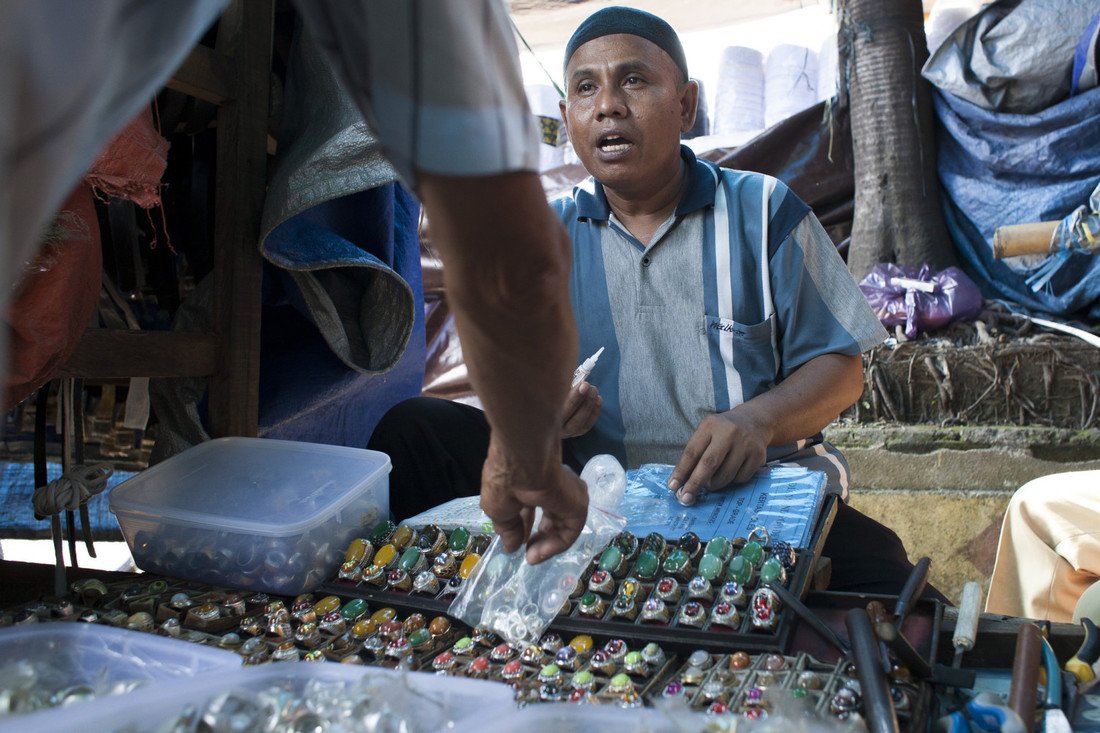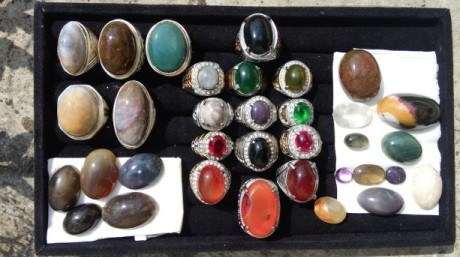
The craze has seen interest in gemstones spread beyond the core constituency of middle aged males. Photo by Flickr user Danumurthi Mahendra.
You can see them at roadside food stalls, in government offices, courthouses, boardrooms, even stuck in traffic. In almost any place or situation you can think of across Indonesia, at least one person will be wearing a large gemstone ring, often on more than one finger. The country is in the grip of a gemstone craze.
It was what brought me to Jakarta’s Balai Kartini exhibition hall on a hot June afternoon, standing in line with hundreds of other gemstone lovers, to register for the final battle of the Indonesia Gemstone Grand Prix, reputed to be Indonesia’s largest ever gemstone competition. Few were deterred by the Rp 400,000 ($AU40) registration fee, a relatively exorbitant sum, instead prizing the opportunity to show off their collections. Many, including myself, were queuing up despite not knowing what prizes were on offer. Word had spread that President Joko Widodo would present the grand prize, although unfortunately the palace quickly refuted rumours of his involvement.
The “final battle” is just the latest chapter in Indonesia’s two-year-long gemstone craze. Everyone from the president down has caught the bug, with gemstones becoming an almost universally favoured topic of conversation. The mainstream media has joined in too, with various columns and extensive airtime dedicated to discussing gemstones. Some local governments have even made it compulsory for civil servants to wear gemstone rings to promote their local stones. But how did the craze first take hold?
Most trace the origins of the current craze to then President Susilo Bambang Yudhoyono’s reputed gift of a bacan doko gemstone (from Halmahera in North Maluku) to US President Barack Obama during his visit in 2010. This story may be apocryphal – no mention is made of such a gift in US federal registers from 2009–2013. Nevertheless, the price of bacan doko stones has risen out of control. To buy one, a gemstone enthusiast must be prepared to spend millions of rupiah.
Yudhoyono also frequently wore gemstone rings, including gems from his birthplace, Pacitan, as well as other regions in Indonesia. His wife, Ani Yudhoyono, documented this habit on her Instagram account, several times posting images of the president’s entire collection. Under a new president, international delegates to the Asia Africa Conference in Bandung in April also received gemstones as souvenirs, causing the price of the stone in question also skyrocket.
Beyond gemstones’ association with high office, what motivates individual gemstone lovers to build their collections? Many enthusiasts profess to have come to the hobby by chance, starting out by following the fashion before developing a genuine appreciation for gemstones. Other gemstone lovers confess a love for the colours of the stones, while some are attracted by the legends that can attach to each gemstone.
Chalcedony stones with patterning resembling a military rank insignia are popular, for instance, because many believe that by wearing the stones their careers will take off. Agate stones are also reputed to bring good fortune to their owners. Vendors often also try to attach stories and unique characteristics to each stone to increase their value.
As the craze has reached fever pitch, the habit has spread beyond its previous core constituency of middle age and older males. These older collectors usually wore gemstones to underline their authority. Now, even five year olds are wearing gemstone rings, and the previously male-dominated pastime has become popular among females as well.
The intense interest in gemstones has spawned a new informal sector in Indonesia’s economy, creating new livelihoods. Visit almost any corner of Jakarta or other Indonesian cities and you are likely to find gemstone craftspeople. The hum of the machines they use to polish the stones is a constant backdrop on roadsides and in markets.
Gemstone stores have also become a ubiquitous sight, with Rawa Bening market in Jakarta emerging as one of the biggest centres in Indonesia, maybe even globally. For the past two years, people from all over Indonesia have flocked to this market, where almost any type of gemstone can be obtained.
The gemstone boom has also driven a proliferation of online stores, such as www.bukalapak.com, www.olx.co.id, www.tokopedia.com. Selling a portion of their collection through these stores can be a way for gemstone enthusiasts to finance their hobby, helping some male collectors to justify their all-encompassing passion to their wives.
A friend adopted a humorous take on this phenomenon on Facebook, and asked: “Are gemstones saving Indonesia?” In his view: “without gemstones, people would just talk politics, and argue all the time! Without gemstones, the economic slowdown would deepen, and the people’s economy would come to a halt! Without gemstones, more people would be unemployed! Without gemstones, crime would rise and hospitals would see an influx of patients, as the end product of acute unemployment! So, long live gemstones!”





